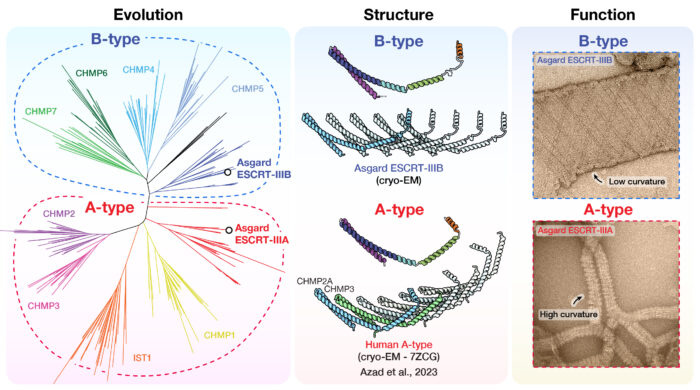ESCRT-III complexes from ancient archaeal cells provide a unique window into the evolutionary origins of eukaryotic cells and reveal how proteins work together to remodel membranes

All cells utilise selectively permeable membranes to encase their interior and, often, to compartmentalise internal organelles. These membranes undergo remodelling to facilitate core processes including cell division and cargo trafficking. Crucial to this, are a family of proteins within the endosomal sorting complex required for transport III (ESCRT-III). In eukaryotes, ESCRT-III machinery is complex, with several subunits and proteins responsible for various jobs in specific contexts, making it difficult to study. To circumvent this, Buzz Baum’s group in the LMB’s Cell Biology Division, have worked with Aurelien Roux’s group at the University of Geneva to investigate the ESCRT-III system in Asgard archaea, an archaeal lineage considered to be the closest prokaryotic relative of eukaryotes. The Asgard archaea ESCRT-III system contains just two proteins, allowing the group to gain new insights into the general principles which govern membrane remodelling, and a unique understanding of ESCRT-III’s earliest origins in archaea more than two billion years ago.
Diorge Souza, a postdoc in Buzz’s group, worked with Tom Williams and Edmund Moody at the University of Bristol to conduct phylogenetic analysis to compare ESCRT-III protein sequences in Asgard archaea with their eukaryotic counterparts. This allowed them to predict that of the two proteins in Asgard archaea, ESCRT-IIIB would initiate the remodelling process on flatter membranes, whereas ESCRT-IIIA would follow on curved membranes, analogous to the functionality of proteins in eukaryotic ESCRT-III.
To study this directly, Diorge, together with the co-first authors Javier Espadas, a postdoc in Aurelien’s group, and Sami Chaaban, a postdoc in Andrew Carter’s group in the LMB’s Structural Studies Division, used fluorescence microscopy and electron cryo-microscopy (cryo-EM) to examine the behaviours of ESCRT-IIIB and ESCRT-IIIA on artificial membranes. This revealed that ESCRT-IIIB is flexible and able to bind membranes of different curvature. Contrastingly, ESCRT-IIIA is more rigid and forms tight, helical filaments causing membranes to take on a tubular shape.
This analysis also revealed the stepwise recruitment of ESCRT-III proteins to membranes, with ESCRT-IIIB binding first and then recruiting ESCRT-IIIA. This mirrors the stepwise process observed between B- and A-type ESCRT-III proteins in more elaborate eukaryotic systems. This is significant as it adds credence to the idea that eukaryotes inherited their ESCRT-III complex from their Asgard archaeal ancestors. Additionally, it illustrates that although the ESCRT-III system has become more elaborate during eukaryogenesis, the core mechanism of membrane remodelling, involving the consecutive action of ESCRT-III polymers with different curvatures, has been conserved across two billion years of evolution.
This research enhances our understanding of how cells rearrange their membranes and offers new insights on fundamental cellular activities such as vesicle transport, membrane repair and the final stages of cell division. Membrane function is disrupted in several diseases, including cancers and neurodegenerative conditions, and an advanced knowledge of this process is crucial to the later development of potential therapies. Finally, the findings in this study apply not just to modern day eukaryotic cells, but also shed light on cellular behaviours throughout Earth’s history. By studying Asgard archaea, the group have glimpsed a transitional stage which separates the simpler operating systems in prokaryotes from those more complex ones acting in eukaryotes, underlining the continuity which connects ancient and cellular systems and all life as we know it.
This work was funded by UKRI MRC, the Wellcome Trust, EMBO, the Swiss National Fund for Research, the European Research Council and the Gordon and Betty Moore Foundation.
Further references
Asgard archaea reveal the conserved principles of ESCRT-III membrane remodelling. Souza, D.P., Espadas, J., Chaaban, S., Moody, E.R.R., Hatano, T., Balasubramanian, M., Williams, T.A., Roux, A, Baum, B. Science Advances
Buzz’s group page
Aurelien Roux – University of Geneva
Previous Insight on Research articles
Membrane remodelling machinery shared across the tree of life